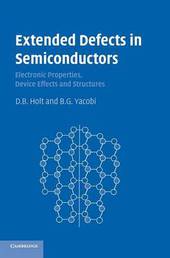
|
Extended Defects in Semiconductors: Electronic Properties, Device Effects and Structures
Hardback
Main Details
| Title |
Extended Defects in Semiconductors: Electronic Properties, Device Effects and Structures
|
| Authors and Contributors |
By (author) D. B. Holt
|
|
By (author) B. G. Yacobi
|
| Physical Properties |
| Format:Hardback | | Pages:644 | | Dimensions(mm): Height 250,Width 182 |
|
| ISBN/Barcode |
9780521819343
|
| Classifications | Dewey:621.38152 |
|---|
| Audience | | Professional & Vocational | |
|---|
|
Publishing Details |
| Publisher |
Cambridge University Press
|
| Imprint |
Cambridge University Press
|
| Publication Date |
12 April 2007 |
| Publication Country |
United Kingdom
|
Description
The elucidation of the effects of structurally extended defects on electronic properties of materials is especially important in view of the current advances in electronic device development that involve defect control and engineering at the nanometer level. This book surveys the properties, effects, roles and characterization of extended defects in semiconductors. The basic properties of extended defects (dislocations, stacking faults, grain boundaries, and precipitates) are outlined, and their effect on the electronic properties of semiconductors, their role in semiconductor devices, and techniques for their characterization are discussed. These topics are among the central issues in the investigation and applications of semiconductors and in the operation of semiconductor devices. The authors preface their treatment with an introduction to semiconductor materials and conclude with a chapter on point defect maldistributions. This text is suitable for advanced undergraduate and graduate students in materials science and engineering, and for those studying semiconductor physics.
Author Biography
David Holt is an emeritus professor in the Department of Materials at Imperial College, London. He obtained his doctorate in Physical Metallurgy from the University of Birmingham, UK, in 1956, after which he held a number of academic positions over five years in the physics department at the University of the Witwatersrand, South Africa, before moving to the Department of Metallurgy at Imperial College, London. He has remained at Imperial College since then, except for a sabbatical year in the School of Physics at the University of New South Wales, Australia, and shorter periods at the Indian Institute of Technology, Kanpur, India. He has been a regular visitor at the Maspec Institute (now part of IMEM) in Parma, Italy. He researched the science and technology of semiconducting materials and devices and developed and applied techniques for their characterization in the scanning electron microscope. He is author or co-author of approximately 150 scientific publications and has co-authored or edited five previous books. Ben Yacobi is an adjunct professor in the Department of Materials Science and Engineering at the University of Toronto. He received his doctorate in physics from the Hebrew University of Jerusalem in 1975. He held post-doctoral positions at Imperial College, London, and Harvard University, and technical staff positions at the Solar Energy Research Institute and GTE Laboratories, US. He has worked in several areas of experimental solid-state physics, including the synthesis, applications and characterization of various electronic and photonic materials and devices. He is author or co-author of over ninety scientific publications and four previous books.
Reviews'This new book is ... a welcome addition, covering as it does extended defects in semiconductors from the basics to the current state-of-the-art. ... extremely readable with a clear, concise style. The presentation is classic, eschewing 'break-out boxes' and other more modern layout innovations in favour of a traditional straight text. The diagrams are equally no nonsense: simple clear line drawings, which as a result effectively convey what are sometimes complex concepts. Lots to crib from here for lecture presentations! ... In their quest to create a single book covering such a large subject area the authors have been surprisingly successful, and the result is an interesting, readable book that serves both as an excellent introduction for postgraduates and a useful reference for those in the field. ... it will no doubt become a regularly consulted reference work in every materials science library.' Chemistry World
|